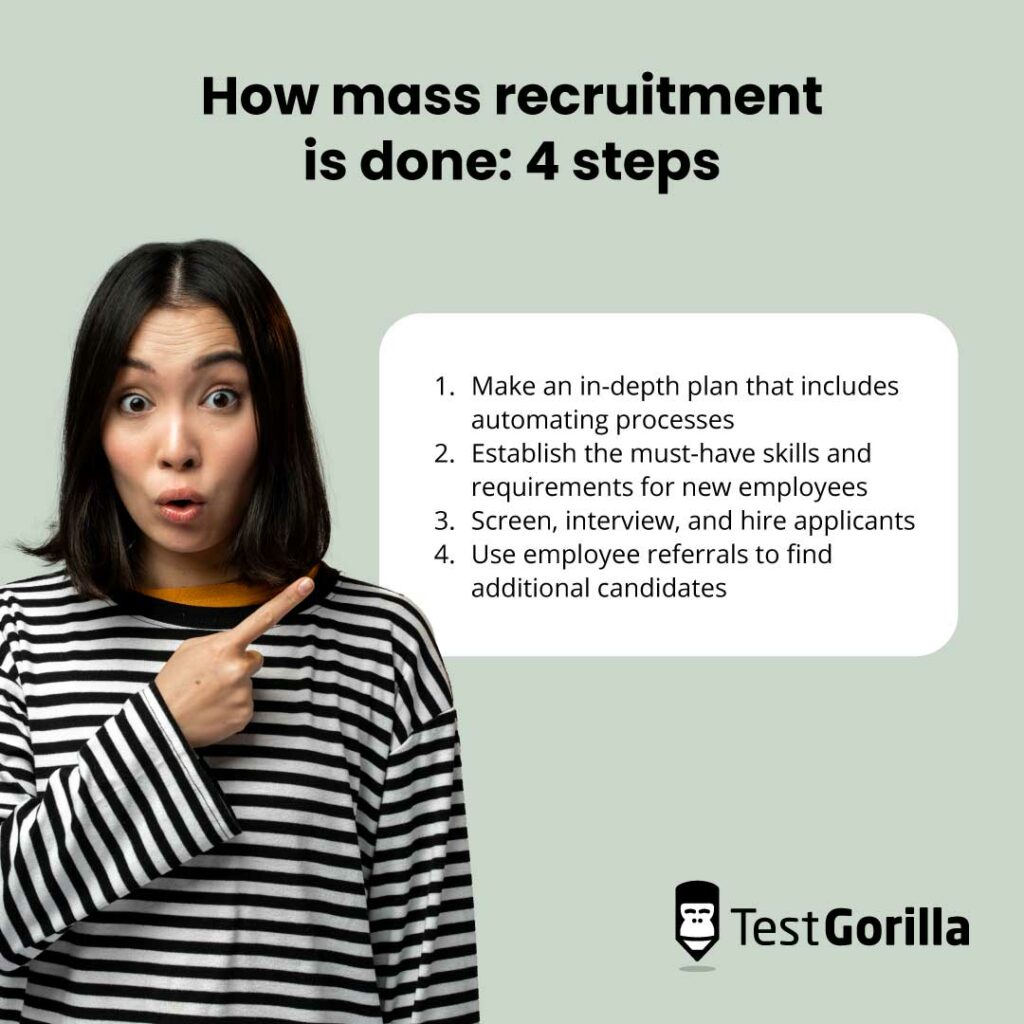Company expansion, the launch of a new product, and receiving a large financial investment: Any of these factors may lead you to start a mass hiring process in your organization.
Mass hiring can provide several advantages for your company, including increased revenue and new product launches. However, you may encounter challenges when screening several candidates at once, or you may simply be unsure which methods to use for bulk hiring.
You can quickly find the ideal talent for your organization with sufficient planning and the right approach (such as using the right Role-specific skills tests). This guide to mass hiring will give you all the facts you need. First, let’s start with what we mean by mass hiring.
Table of contents
What is a mass hiring process?
Mass hiring is a method recruiters use to hire several employees simultaneously. Often, bulk recruitment firms handle the mass hiring process; however, you can also handle the process within your organization.
Because bulk hiring should happen quickly, many recruiters consider it daunting. Unlike low-volume or traditional hiring, bulk hiring requires automated processes and efficiency. Nevertheless, although manual processes during bulk hiring are not as useful as they are in low-volume hiring, thoroughly screening applicants is still crucial.
The mass hiring process may be particularly important for organizations that have let thousands of workers go. For instance, in the tech industry, more than 150,000 tech workers were fired in 2022; businesses in this field may integrate a mass hiring process to replace former employees with top talent.
How mass recruitment is done: 4 steps
So, how is mass recruitment done? Following the four key steps below can help you complete the process easily.
1. Make an in-depth plan that includes automating processes
When you plan for your mass hiring process, consider each phase and the methods you can use to automate certain stages. Before you begin the process, consider where you will advertise job vacancies, the best time to start advertising, when you will conduct interviews, and how to select candidates.
During the process, think about how you will share information about the hiring process with candidates, whether you will automate the communication process, and how many interviews you aim to conduct each day.
Don’t forget to also decide which skills tests your candidates should complete. For example, Culture Add tests or personality tests will help you evaluate whether your applicants are a good match.
After the mass hiring process, consider how you will manage onboarding and who will create training sessions for new hires.
2. Establish the must-have skills and requirements for new employees
With your fully-fledged plan, you can now establish the must-have skills you are looking for from candidates. Since mass hiring requires you to search for multiple employees quickly, you may not be able to screen employees as thoroughly as you would in a low-volume hiring process. With this in mind, ensure you prioritize the required skills for the role.
For instance, if you need to hire several developers for your organization, consider whether they have the ideal soft skills and technical programming skills required for the role.
If you are hiring various content writers, evaluate them on their understanding of SEO. Assessing these skills doesn’t have to be complicated – keep reading to find the best method for this process.
3. Screen, interview, and hire applicants
Screening and interviewing applicants in a mass hiring process may seem overwhelming, but using skills-testing platforms will make things easier. Skills testing partially automates the screening process and eliminates the need to review resumes.
Suppose you’re hiring multiple-site reliability engineers and have established that Python or Java coding skills are crucial for the role. In that case, you can invite all applicants to complete a Python skills test or a Java test. Effective online skills testing makes assessing your candidates simple.
Once you have completed skills testing, you can proceed to the interview phase. Without the right techniques, this stage may lead to delays in the bulk hiring process.
Therefore, consider group interviewing (in which you interview candidates in batches), video hiring (in which you use video software to meet candidates virtually), or one-way interviewing to reduce the complexity and time-consuming interview process.
4. Use employee referrals to find additional candidates
So, you’ve now hired several employees. But what if you still need to source more candidates? Next on your list should be an employee referral method.
Incentivizing your team to provide referrals will help you speed up the candidate-sourcing process. Inform your new hires and existing team of your referral scheme and the rewards you will offer if they provide your organization with good referrals.
What are the best mass hiring tools?
There are various mass hiring tools, but two of the most useful include skills testing platforms and video interviewing tools – both are available with TestGorilla.
Skill-testing platforms make it easy to automate candidate screening and reduce your time-to-hire metrics. You can use platforms such as TestGorilla to:
Assess personality and behavioral traits
Hire quickly and avoid unconscious bias
Review must-have technical skills
The one-way video interviewing tools we offer at TestGorilla help you complete the interview stage faster. You can send a bulk interview invitation to all candidates, asking them to respond to pre-recorded interview questions via our tool. It automates the interview process without compromising on quality screening.
Mass hiring and automation: 4 dos and don’ts
Automation is a vital part of mass hiring. However, you must proceed with caution and plan carefully. Here are our four dos and don’ts to consider when automating your bulk hiring process.
1. Do send skill test invitations in bulk to candidates
To quickly and thoroughly screen applicants, send skill test invitations in bulk to all your applicants. This approach will help you avoid manually screening resumes and focus on a data-driven hiring process without sending skill test invitations to each candidate individually.
2. Do use one-way video interviewing
When hiring multiple candidates, forget telephone or in-person panel interviews. You won’t have time to complete this phase as it’s too time-consuming. Instead, use a one-way video interview to automate the process.
First, record your interview questions. Then, wait for your candidates’ responses and review them when they are in. It’s that simple.
One-way video interviewing will give you insights into your candidates’ personalities and how they will fit into your organization, so it’s a valuable part of the hiring process.
3. Don’t automate every part of the hiring process
There are time constraints with bulk hiring, which may make it tempting to automate all phases of the process. But doing so can ruin the candidate experience.
For instance, you may use automated email messages if you want to notify past applicants that your organization has a new opening – but ensure you include a personal touch when giving candidates positive updates about their applications to enhance the candidate experience.
4. Don’t forget about unconscious bias in the automation process
If you automate some processes, such as resume screening, don’t forget that unconscious bias may impact the hiring process even with resume screening tools.
Although you may consider using resume screening tools, they can make mistakes and exclude certain candidates due to the data you feed them (which may be biased). Instead, consider skills testing methods instead of automated resume screening approaches to avoid unconscious bias.
Bulk hiring: How to hire 100 employees
Now you understand the principles and core issues of mass hiring. There are, however, other factors that help make your bulk recruitment a success. So let’s look at a few important tips that will enable you to hire 100 employees at once.
1. Establish a unified hiring team
Establishing a unified hiring team will reduce the number of disagreements you may experience when hiring hundreds of applicants in a short time. To achieve this, you need to ensure your hiring team is familiar with the requirements of the role and the objectives of the recruitment process.
2. Use social media such as LinkedIn
With social media tools like LinkedIn, you can quickly source many passive candidates and search for additional candidates to widen your pool.
3. Plan onboarding and training based on skills tests
Creating an onboarding plan can be complex when hiring 100 new employees, but skills test results will help you create an effective training program. First, review the test results and consider which skills your candidates may lack or need to improve. Then, foreground these skills in your new employees’ training program.
Complete your mass hiring process effortlessly with skills tests
Mass hiring may seem overwhelming, but you can complete the process easier by planning and using the best tools. Check out our skills test library for the best tools to screen candidates efficiently and hire multiple candidates quickly.
Sign up for a free trial to complete the mass hiring process effortlessly.
Related posts
Hire the best candidates with TestGorilla
Create pre-employment assessments in minutes to screen candidates, save time, and hire the best talent.
Latest posts
The best advice in pre-employment testing, in your inbox.
No spam. Unsubscribe at any time.

Hire the best. No bias. No stress.
Our screening tests identify the best candidates and make your hiring decisions faster, easier, and bias-free.
Free resources
This checklist covers key features you should look for when choosing a skills testing platform
This resource will help you develop an onboarding checklist for new hires.
How to assess your candidates' attention to detail.
Learn how to get human resources certified through HRCI or SHRM.
Learn how you can improve the level of talent at your company.
Learn how CapitalT reduced hiring bias with online skills assessments.
Learn how to make the resume process more efficient and more effective.
Improve your hiring strategy with these 7 critical recruitment metrics.
Learn how Sukhi decreased time spent reviewing resumes by 83%!
Hire more efficiently with these hacks that 99% of recruiters aren't using.
Make a business case for diversity and inclusion initiatives with this data.





















